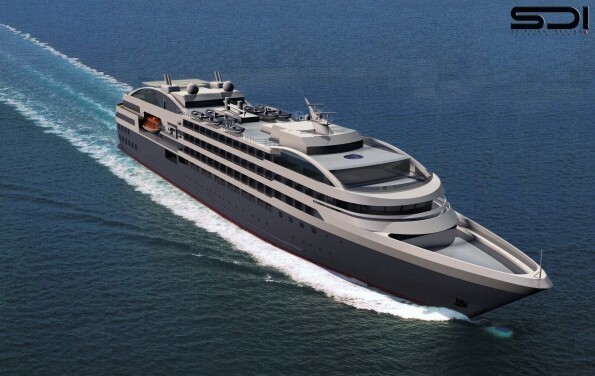 Today, a cruise ship’s wake must be environmentally clean and “green.”
Today, a cruise ship’s wake must be environmentally clean and “green.”
“It is a very complex issue, but the environment is almost everything today,” explained Karl Morten Wiklund, director of passenger ships at Det Norske Veritas (DNV). The operating challenges require the best marine engineering practices and the latest innovative technologies to ensure that no untreated airborne or liquid emissions are left behind to compromise the marine environment.
IMO’s Mandated Air Emissions
A growing public awareness about the negative environmental impact of the maritime industry’s use of lowest cost – highest emissions fuel oil – is threatening severe local restrictions on world shipping’s discharge of sulfur exhaust emissions. As a result, in April 2008, the IMO’s Marine Environment Protection Committee (MEPC) recommended far-reaching changes to Annex VI’s air emission requirements and the vote for final approval will occur later in the year.
Those recommendations, if implemented, will require progressive vessel reductions of SOx emissions by initially reducing the fuel sulfur cap of 4.5 percent to 3.5 percent effective in 2012, with progressive reductions to 0.5 percent globally by 2020. Feasibility reviews to achieve the final 2020 goals would be completed by 2018. At the same time, fuel sulfur limitations in Sulfur Emission Control Areas (SECA) would be reduced from the present 1.5 percent to 1 percent by 2010 and to 0.1 percent by 2015.
“At DNV, we think it’s a wise decision by the IMO. To me it is very simple: Very poor quality fuel should not be burned onboard ships,” Wiklund said.
There are concerns among many shipowners questioning if the new proposed regulations are workable. Two related issues are whether sufficient supplies of low-sulfur fuels will be adequate where and when needed and at what cost. The MEPC recommendations have addressed the concerns offering shipowners alternative approaches when still using higher-sulfur fuels if the ships are equipped with appliances or use other compliance procedures that “are at least as effective in terms of reductions as that required by this Annex.”
For sulfur emissions, achieving the mandatory emission reductions without using low-sulfur fuel, the alternative would be installing exhaust gas SOx scrubbers.
After reviewing the technical complexities of retrofitting SOx emission scrubbers to existing vessels and the operational issues for all vessels, Germanischer Lloyd (GL) believes “that it is better to use cleaner fuels than to clean the exhaust gases. One issue is that because of the reaction products of the scrubber process there will be a large amount of contaminated water for disposal,” said Wolfgang Wehlte, environmental passport team project engineer with GL.
Future Clear Power Technologies
Advancing diesel-engine technologies based on conventional fuels have steadily resulted in greener ship operations by reducing emissions of NOx, SOx and PM, plus improving fuel efficiency. However, significant emission reduction benefits using dual fuel diesel engines burning fuel oil and gaseous fuels have performed successfully as LNG tanker propulsion power and where LNG is available to power offshore vessels and an auto-passenger ferry since 2000.
One reality, Wiklund explained, is “because there already are gas installations on domestic ferries with several hundred passengers, we have trust in their safety record and should also recommend the fuel for other segments of shipping.
“DNV has proposed that LNG should be accepted by the IMO for all kinds of ships including cruise ships. DNV has made a very clear statement.”
Wehlte agreed that LNG power “is a practical approach,” but industry and regulatory acceptance “may be difficult,” and in the future distillate fuels with very low sulfur-content will likely remain the fuel of choice.
Still, Wiklund said the bottom line is the advantages of LNG fuel over conventional fuels: “It’s a far cleaner fuel. It produces less carbon. It’s more efficient. And it is cheaper.”
Biofuels as an alternative to conventional petroleum-based fuels have been evaluated and tested by cruise lines. Concerns range from compatibility with existing diesel engines, the amount of energy required to produce bio-fuels and some shipowners’ experience that bio-fuels are less efficient than petroleum-based fuels, therefore requiring 10 to 15 percent more fuel to be burned.
In the future, fuel cells will have wider use as a power source aboard cruise ships. Wiklund said DNV “believes the technology will develop significantly in the years to come. The technology is in place; the challenge is to make this technology in Megawatt units big enough to serve the shipping community.”
On a smaller scale of the coming trend, the 150-passenger short range cruise vessel Elding I in Iceland has been converted to dual diesel-hydrogen fuel cell propulsion power. The ship’s quiet and non-polluting fuel cell system was certified by GL.
Excerpted from Cruise Industry News Quarterly Magazine: Summer 2008




